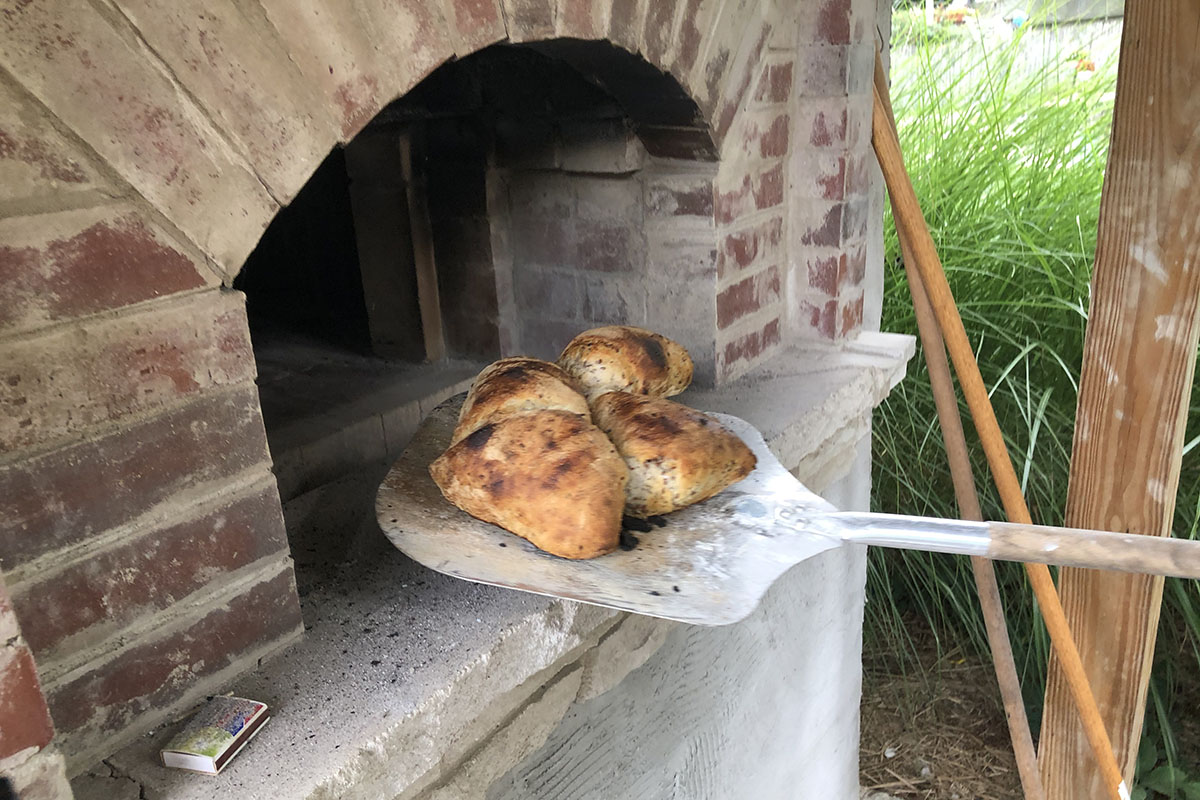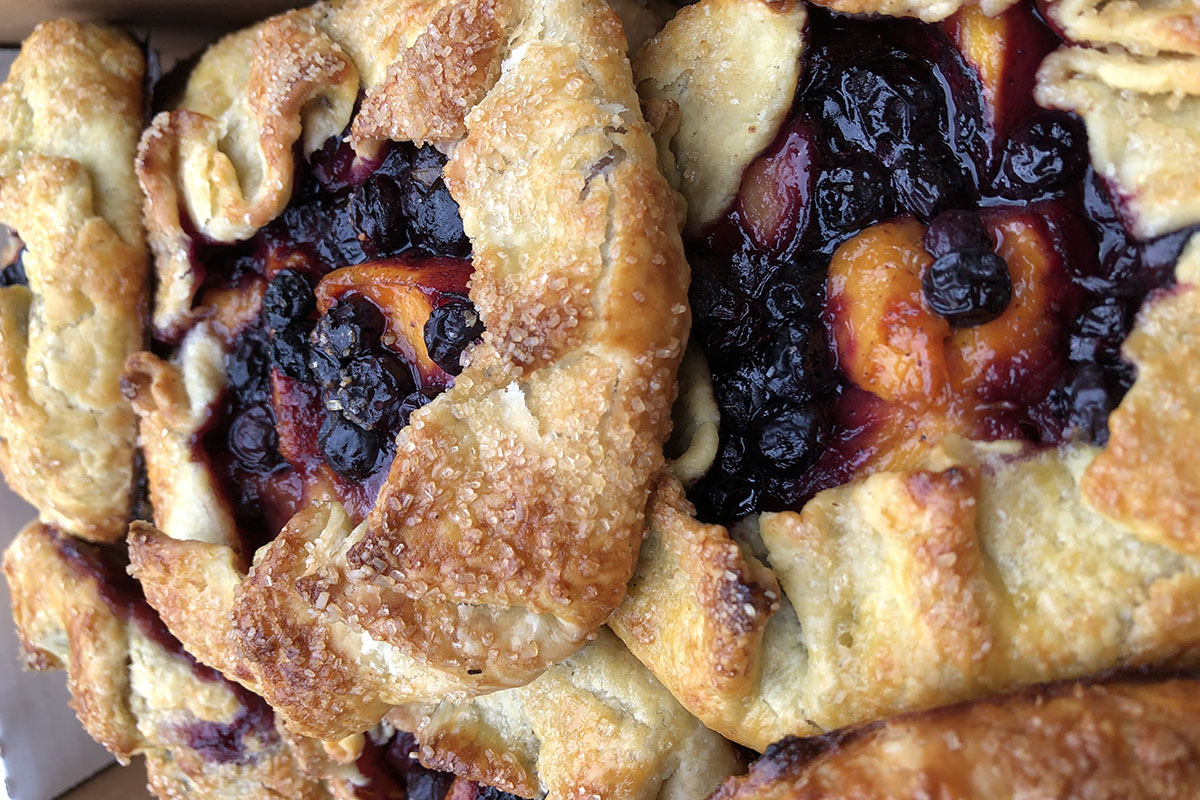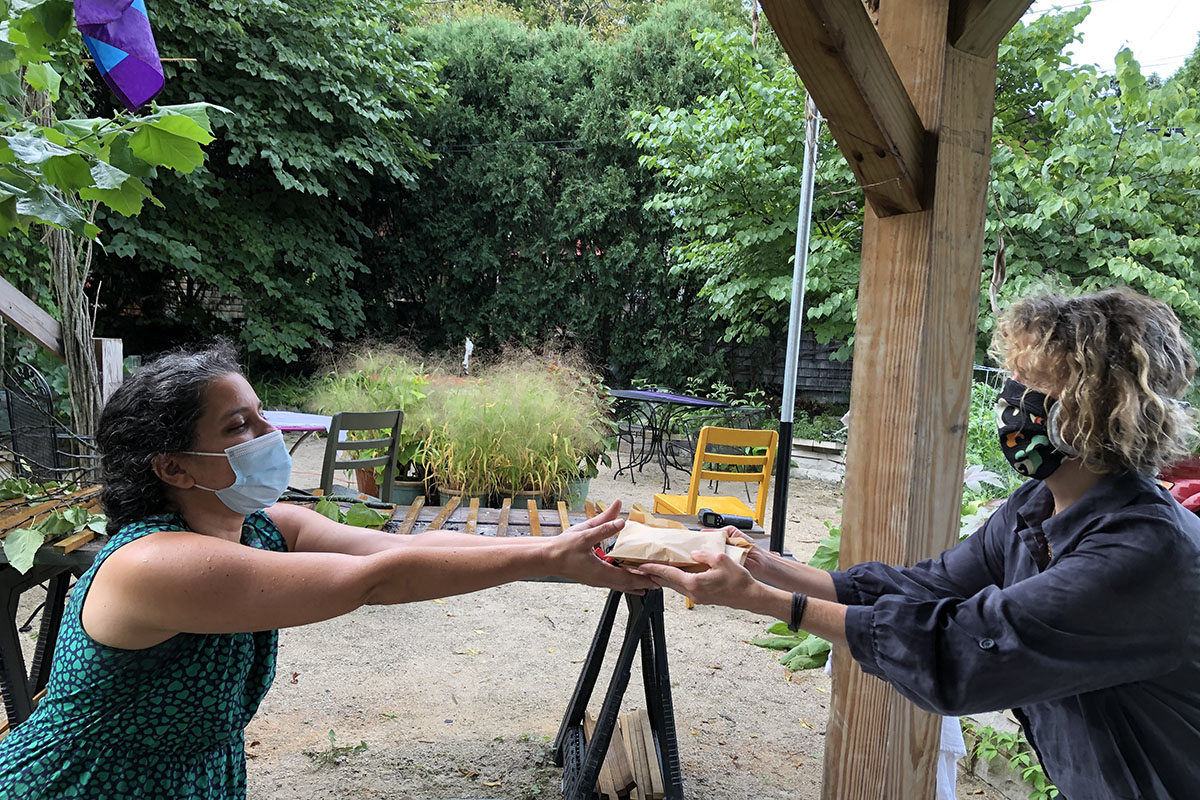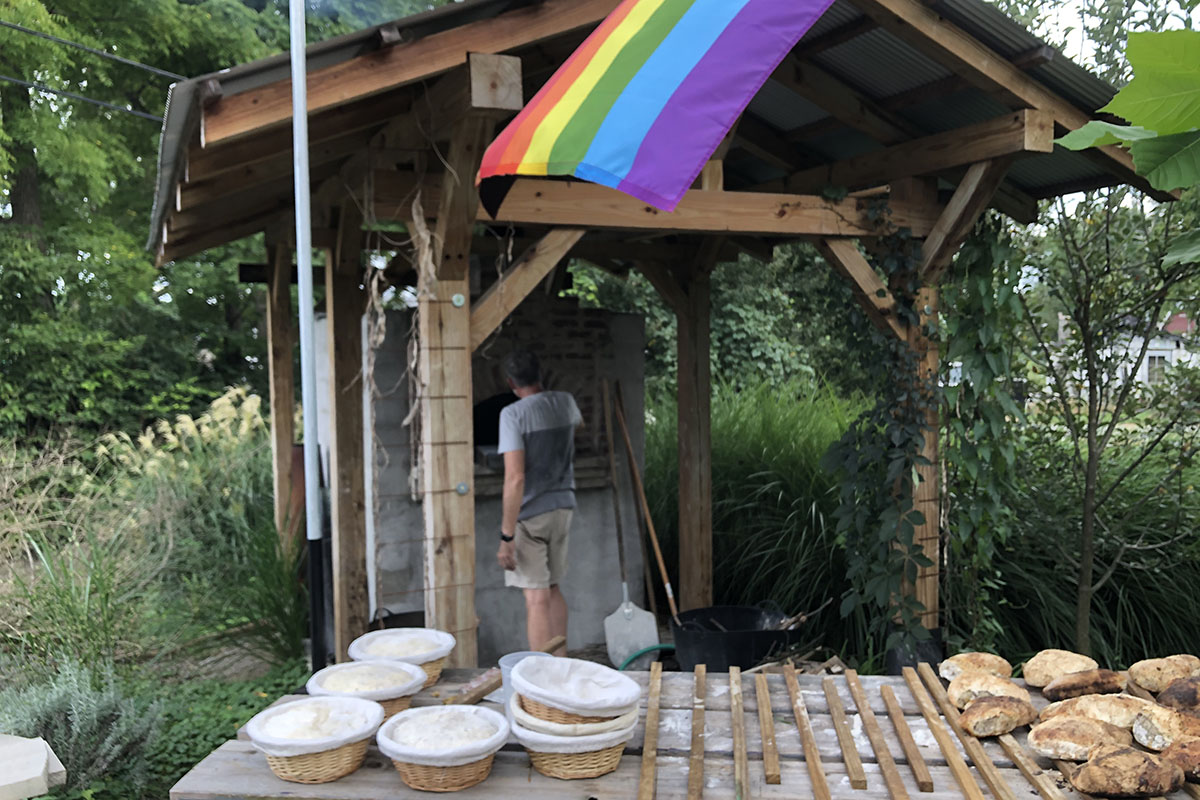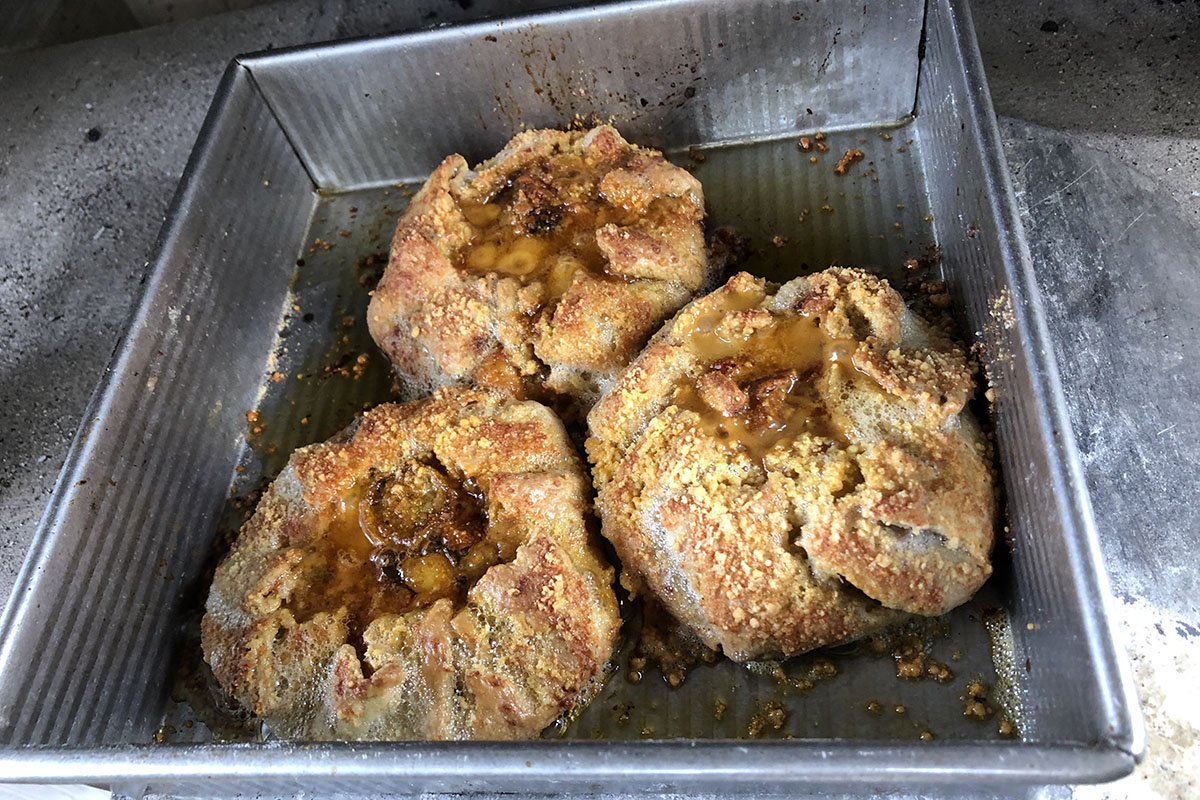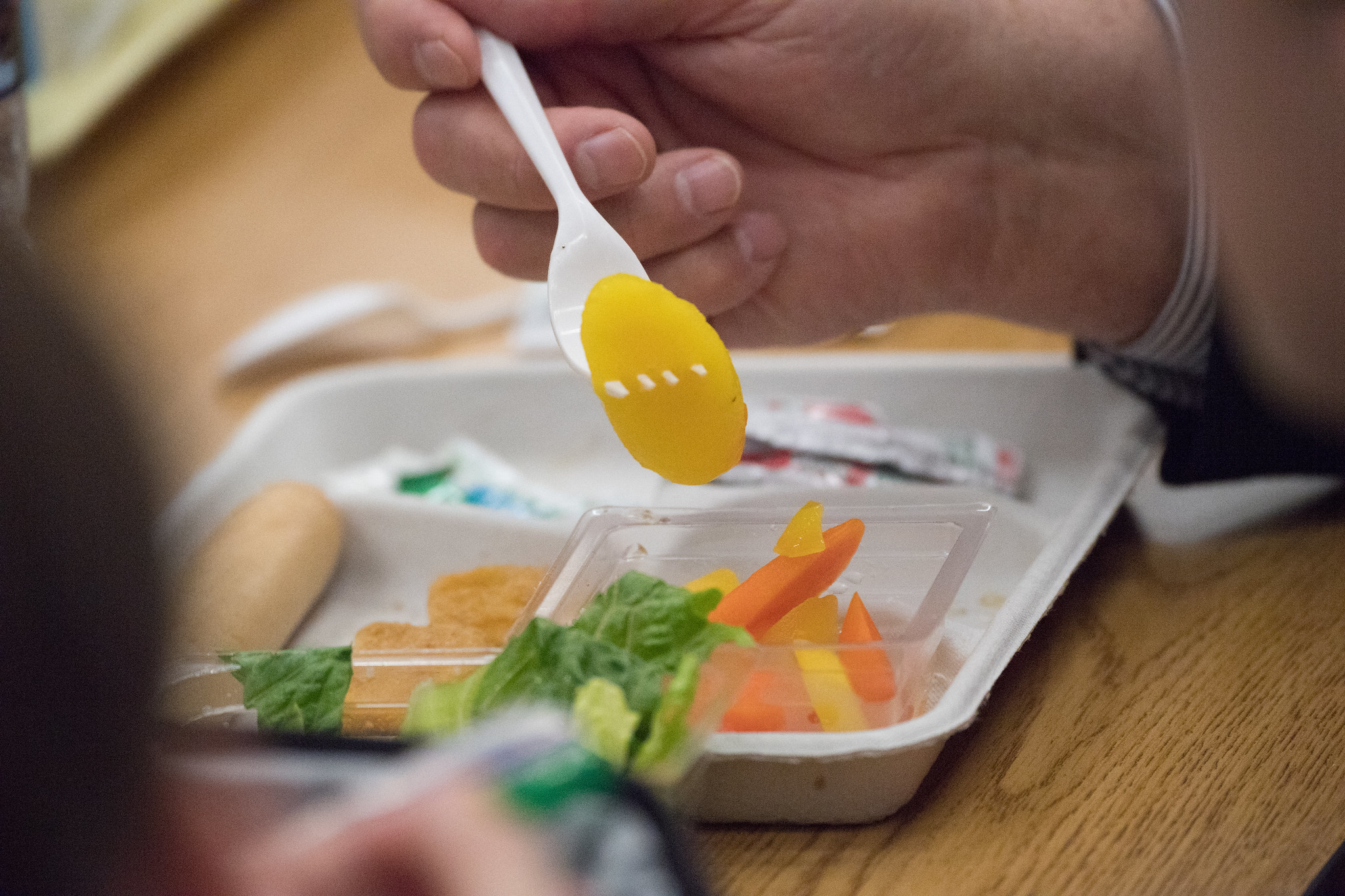KAYTE YOUNG: Production support for Earth Eats comes from Bloomingfoods Coop Market, providing local residents with locally sourced food since 1976. Owned by over 12,000 residents in Monroe County and beyond. More at Bloomingfoods.Coop. And Elizabeth Ruh, Enrolled Agent with personal financial services. Assisting businesses and individuals with tax preparation and planning for 15 years. More at PersonalFinancialServices.net.
(Earth Eats theme plays)
From WFIU in Bloomington Indiana, I'm Kayte Young and this is Earth Eats.
KEITH ROMAINE: I've found that making smaller loaves is better, so they're little guys. They look like little animals when they get done.
KAYTE YOUNG: This week on our show, we visit a backyard brick oven and talk with Keith Romaine and Amy Roche about their neighborhood pop up bakery. And we head over to Cardinal Spirits for a fall cocktail recipe featuring apples. That's all just ahead.
Let's start with Renee Reed and the news. Hi Renee.
RENEE REED: Hello Kayte.
A group of black farmers say Monsanto's nearly $11 billion dollar settlement of Roundup related lawsuits earlier this summer wasn't enough. As Corinne Ruff reports for Harvest Public Media, a lawsuit filed last week in a Missouri federal court calls for the ag giant owned by Bayer to stop selling the weed killer.
PROTESTORS: Black farmers matter! Black farmers matter!
CORINNE RUFF: Attorneys, farmers, and activists gathered outside Bayer's Creve Coeur office to voice their support for a lawsuit that urges more relief for black farmers who used Roundup. Saint Louis County NAACP President John Bowman says it's a social justice issue.
JOHN BOWMAN: Black farmers have been trapped into using a dangerous product. And they are paying for it with their economic freedom, their health and in some cases their lives.
CORINNE RUFF: Earlier this summer Bayer agreed to settle about 100,000 lawsuits claiming Roundup caused people cancer. The company said in a statement claims that black farmers were treated differently in that process were false. It also said the latest lawsuit has no basis and that its products are safe. I'm Corrine Raff.
RENEE REED: Agriculture Secretary Sunny Purdue said in a recent letter to lawmakers that the USDA would end a school meal waiver program by September 30th. On August 31st the agency abruptly changed its stance, announcing that those measures would extend through the end of the school year in December.
Since schools closed in March, the school meal waivers have made it easier for kids to pick up free meals, extending this service to children who are not of school age, and expanded the income levels needed to qualify. The moves also allow coordination with local community organizations to make meal pickups easier for families who do not live close to a school.
In the early days of the pandemic, the agency dragged its feed among calls to extend the benefits. With hundreds of anti-hunger and child advocacy groups pushing for the white house to extend benefit that have been authorized in the COVID-19 Child Nutrition Response Act through September 30th. In the August 20 letter, responding to pressure for extensions, Purdue claimed that the emergency law would not allow the agency to keep the flexibility measures in place. But amid a growing outcry, a little more than a week later on August 31st, the agency suddenly pivoted - announcing the waivers would be available through the end of the year.
Thanks to Corrine Ruff and Chad Bouchard for those stories. For Earth Eats News, I'm Renee Reed.
(Earth Eats news theme)
(Relaxing banjo transition music)
KEITH ROMAINE: So I was said, "Oh, okay. Well I’ll just make woodfired bread oven in the backyard." Couldn't be that hard.
KAYTE YOUNG: When Keith Romaine dreamed of building a brick oven in his backyard almost 7 years ago, he was picturing neighborhood gatherings and festive evenings featuring hot pizzas, steamy loaves of fresh baked bread, and bottles of wine and cold sparkling water passed across tables. In other words, he wasn't picturing life in a global pandemic. But now that his wood fired brick oven is finished, and his backyard has been transformed into a lovely garden piazza, he's finally ready to start baking bread and sharing it with his community. He and a friend have recently started a pop-up bake sale on Friday evenings in Bloomington Indiana. I paid a visit to Keith's place, which is just a few blocks away from my house.
(Sound of gravel crunching underfoot. Forest sounds; insects chirping)
Keith's house is nestled in a shady almost wooded magical looking alley. His yard is filled with trees and vines and lush ground cover, and this lovely front porch. He's got a kind of a gnarled and twisted beautiful old redbud in the front. And as you go down this alley it's like you enter a microclimate. The temperature drops like 10 degrees, so it's a very secluded feeling, kind of tucked away.
And Keith pays a lot of attention to aesthetics. He's an artist and he has created an oasis here in McDoell Gardens Neighborhood. He has a lovely patio space that he has designed and built with stone walls and edible garden beds and climbing flowers. It’s really a gorgeous space.
He refers to it as the piazza, complete with a gurgling fountain in the center surrounded by feathery plants. I stopped by in the late morning when Keith was just getting the fire started.
KEITH ROMAINE: Just to build a good fire and then this maybe obvious but newspaper and paper, wad it up, and then add little twigs, little guys. These are just things that are left over from my yard honeysuckle.
(Sound of a match being struck)
So the goal is to keep building it up and building up until it's a basically a roaring fire. And the inside of the oven will get up to around 700-750. You wanna use wood that burns hot and fast.
KAYTE YOUNG: Do you have any kind of dampers or louvers or anything like that?
KEITH ROMAINE: Nope it just goes straight up. It's not like a regular fireplace that has the chimney right above the fire. When it's sealed off with the bread in it is to completely airtight, allowing steam to build up.
KAYTE YOUNG: Okay so having a chimney right inside of the chamber wouldn't really work.
KEITH ROMAINE: Yeah that's the reason why regular home ovens don't work, because they let air in and out.
KAYTE YOUNG: By "don't work", Keith means you can't get that crusty bake with full ovens bring very easily on your home baked bread in part because home ovens usually don't get hot enough, and also because they don't trap steam as well as a brick oven like his does.
KEITH ROMAINE: The fire's going good now.
(Sound of fire crackling)
And I'll just keep building the fire for the next... five hours I'm going to keep building it. This is called a black oven, it's an oven where you build the fire inside the chamber where the bread is going to be. And the oven is built so that it has very thick masonry walls, first with fire brick that's closest to the fire, and then on top of that is quite a lot of concrete and then on top of that is vermiculite insulation to hold the heat in.
KAYTE YOUNG: So you're heating up the interior space and those bricks and they're holding that heat...
KEITH ROMAINE: Yes.
KAYTE YOUNG: Throughout the baking process.
KEITH ROMAINE: Mhm, exactly. How that works is that I get the oven heated up and then I pull out all of the ashes and swab it out with a towel, it'll be wet. So then it'll be about 700 degrees, and I put in the first batch of about 16 loaves. And I've found that making smaller loaves is better, because when you have a really hot oven it's too hot to cook all the way through if the loaves are big. So they're little guys, they look like little animals when they get done, they're cute.
KAYTE YOUNG: What Keith means by "too hot to cook all the way through" is that the outside of the bread might get too crispy or even burnt before the interior has a chance to fully bake. So for now he's sticking with smaller loaves. We'll return to Keith's brick oven later in the show for bread baking and a neighborhood popup bake sale.
(Relaxing banjo music)
Just a hop skip and a jump away from Keith Romaine's brick oven piazza is Cardinal Spirits Distillery. Though it's been a rough summer for restaurant and bars, Cardinal Spirits has rolled with the punches. They've been making and distributing hand sanitizer and offering online ordering and carryout for their handcrafted spirits, canned cocktails, and meals from their restaurant. Last fall I visited with guest bartender Scott Lowe who showed me how to make an apple centric cocktail.
SCOTT LOWE: And I'm the Indiana Sales Manager for Cardinal Spirits. But I've been a bartender for about... well, I’ve been in the business for about 30 years. And I've been a bartender most recently in the Indianapolis area for about 18 years.
We are going to make a fall-inspired cocktail and that's going to utilize our Cardinal Standard Dry Gin, along with some Indiana apple cider, and some locally-sourced honey from the owner's apiary up in Fort Wayne area, that I infused with cinnamon sticks and a little bit of fresh lime juice.
Much of what I do focuses on seasonality, whether that be fall, winter, spring, summer, and utilizing those fruits or vegetables or herbs that kind of go along with that season. So certainly for fall, apples, I think apples. I love apples. And the apple cider that I'm using is actually from an orchard from northern Indiana, and that's actually in my hometown of La Porte Indiana. So, I'm kind of utilizing some local ingredients that are kind of near to my heart.
We're going to start with two ounces of our Cardinal Standard Dry Gin, which is a juniper-forward traditional dry style gin with a ton of citrus. So, we add juniper berries, coriander, orange zest, lemon zest. And in the basket - it’s a botanical basket that we have on one of the columns of our still, it’s on the very last column, and then the liquid vapor passes over the botanical and actually infuses into making a gin. So, it's very clean dry gin, and we're going to use two ounces of that.
(Sound of a cork popping, and gin being poured)
And I'm going to put this is in a shaker tin. And then next I will add one ounce of Indiana apple cider - Garwoods Orchards, LaPorte Indiana. I will then add three quarters of an ounce of lime juice and then I will add the cinnamon infused Cardinal honey from our owner's farm up in Fort Wayne Indiana. And then I will take that and add some ice to the tin...
(Sound of ice chinking as it is poured into the tin)
KAYTE YOUNG: At first, I thought you said a shaker tin, but then I realized you were saying tin.
SCOTT LOWE: Yes, shaker tin, that's a shaker tin, is one of the most important parts of a bartender's arsenal as far as equipment is concerned or tools. So yeah, this basically, for any shaking cocktail used with citrus, allows the proper dilution factor and keeps the drink nice and cold. And it's a stainless steel so it's easy to clean. And it doesn't take on, if you're making several different type cocktails with different ingredients, it doesn’t hold onto those ingredients once they've been poured out.
(Sound of ice being scooped)
And then I'll cap that, and I'll give it a shake for about 20 seconds. We want a dilution of about 20%. So, that kind of infuses the ice and makes it a nice cold drink and it doesn't make it too boozy.
(Sound of ice and drink shaking in tin)
You know it's ready when the sides of the shaker tin are ice-cold to the touch. And so, I'll take my Hawthorne strainer and I’ll put it over the top of the shaker tin. And then I’ll take my double strainer, which is a fine mesh shiv, that is gonna extract all of the shards of ice, so it doesn't continue to dilute. And then I’ll be adding to some ice to the glass.
KAYTE YOUNG: So, you're removing the ice and then you're adding the ice.
SCOTT LOWE: Correct, yes. So, you're removing the ice just because those... the fine ice, you can see this in your shaker tin when you're looking at it. You see these fine little crystals of ice. If those remain in the drink, they dissipate very quickly so it’s just gonna water down your drink, but larger cubes are gonna take longer to dilute so... and you want to keep the drink cold.
And then I'm just gonna garnish it with a nice thin slice of an Indiana apple.
(Sound of apple being chopped)
Just gonna set that right on top here... there you are.
KAYTE YOUNG: Oh, it's gorgeous.
SCOTT LOWE: That is the Apple-A-Day cocktail.
KAYTE YOUNG: That's great. It’s so simple.
SCOTT LOWE: My favorite cocktails are the simplest to make. As long as you're using really good quality ingredients and fresh juices, then you really need a whole lot of ingredients total. You know, just keep it simple. Make it nice and easy for everybody to kind of understand and be very approachable.
KAYTE YOUNG: Do you mind if I taste it?
SCOTT LOWE: Sure.
KAYTE YOUNG: Yeah that is really simple, it's clean. It's crisp like an apple, like nice... crisp.
SCOTT LOWE: And it also allows the spirit to still have... to be present. You don't want to... there's a reason why you're using a really good gin, you want to be able to taste that gin and the components of that gin as well.
KAYTE YOUNG: Yeah, I like the honey. The honey in there is nice. It goes really good with the apple. The honey and the cinnamon are very subtle, like they're just adding a warmth, but it’s not like you're going, "cinnamon!" You know, it’s just a subtle warmth.
SCOTT LOWE: It's not taking over the cocktail, yeah. And that's again, that's the balance part of the factor of the cocktail.
KAYTE YOUNG: Well, that's wonderful thank you.
(Upbeat, country music featuring a banjo plays)
[Narrating] Find the recipe for Scott Lowe's apple a day cocktail featuring Cardinal Spirit's gin at EarthEats.org
(Earth Eats Production Support Theme Music)
Production support comes from:
Bill Brown at Griffy Creek Studio, architectural design and consulting for residential, commercial and community projects. Sustainable, energy positive and resilient design for a rapidly changing world. Bill at GriffyCreek.studio.
Insurance agent Dan Williamson of Bill Resch Insurance. Offering comprehensive home, auto, business and life coverage, in affiliation with Pekin Insurance. Beyond the expected. More at BillRescheInsurance.com
And Bloomingfoods Coop Market, providing local residents with locally sourced food since 1976. Owned by over 12,000 residents in Monroe County and beyond. More at Bloomingfoods.Coop.
(Transition music featuring slow banjo strumming and hand drums)
We're back with Keith Romaine and his wood fired brick oven in his backyard piazza. He's been stoking the fire and heating the oven for more than five hours now, and he's already put the first batch of bread loaves into the oven. While they bake, he sets up his makeshift cooling rack on the redwood plank table in front of the stove.
KEITH ROMAINE: These are not special bread boards. They're two by fours that have been ripped.
KAYTE YOUNG: The cooling rack consists of thin strips of wood arranged about four inches apart across one third of the table.
KEITH ROMAINE: It works, because they need to breathe a little bit, if they don't the bottoms get all soggy.
KAYTE YOUNG: So what kind of bread is this? I'm seeing a lot of seeds.
KEITH ROMAINE: It's a sourdough, and it's all organic, whole wheat flour, all-purpose flour, and bread flour, and then it has chia seeds and flax seeds in it. And those aren't just for nutrition but they make the bread... one of the things that I love about bread when it's really yummy to me is this that it's almost... it melts in your mouth on the inside and it's lightly crispy on the outside, as opposed to being dry on the inside. I'm not a fan of that kind of bread anymore.
They describe it, bread people, as pudding. But it's not, it's cooked. It rises and it can cut like slices, so it's not like gooey. The other thing about this kind of bread is that it lasts for about five days as opposed to regular sourdough, by the time the next day comes it's already... now it's a day old.
I just put it in, and you saw I just closed it. But I should check it.
KAYTE YOUNG: Okay.
KEITH ROMAINE: Because it's hot in there.
KAYTE YOUNG: [Narrating] It was time to check on the first batch of bread in the oven.
(Sound of metal scraping over brick)
KAYTE YOUNG: Oh wow, those definitely got their oven spring, didn't they?
KEITH ROMAINE: They did! And it's so amazing.
KAYTE YOUNG: Once the loaves are out, Keith turns to the dough, resting lemon lined baskets on the other two thirds of the table. He flours the long-handled paddle shaped metal peel and turns the dough ball onto it.
KEITH ROMAINE: And I what I do with these loaves, these are about two pounds. So I cut them into four and then stick the... I stretch them a little bit but mostly I don't do too much to them because they don't need it. They just grow in the oven.
KAYTE YOUNG: Okay.
KEITH ROMAINE: In their own little funny shapes.
KAYTE YOUNG: [Narrating] He quickly slides the loaves into the back of the oven and prepares three more rounds for a total of 16 loaves per batch. Once the loaves are inside, he fits the thick metal door over the oven's entrance and notes the time.
KEITH ROMAINE: These are really beautiful; I like that they're not all exactly the same. What's interesting is that I'm a fiber artist and when I was in graduate school I would make things that looked kind of like this. I had no idea that I was getting ready to make bread.
KAYTE YOUNG: You mean that looked like the finished loaves?
KEITH ROMAINE: Yeah. They're...
KAYTE YOUNG: [Narrating] I asked Keith about the backstory to his wood fired brick oven.
KEITH ROMAINE: So about 10 or 15 years ago I start having dinner parties at my house. And then I went to Italy and discovered that they're was better bread in some places of the world then there is in Bloomington.
So I said, "Oh okay, well I'll just make a wood fired bread oven in the backyard" Couldn't be that hard.
So I planned it and thought about it, and dreamed about it, and read lots of micro bakery success stories. With a group of people we created a Kickstarter campaign.
KAYTE YOUNG: [Narrating] They raised around $8,000, $3,000 of that came from Keith himself, but the project ended up being much more involved than they anticipated, as projects often are. The total cost was closer to $20,000 and it took nearly seven years to complete.
KEITH ROMAINE: I needed a way to get from the kitchen to the oven... it was a 10-foot drop. I built stairs, built a porch...
KAYTE YOUNG: [Narrating] And he built the piazza which required some earthwork, and the building of stonewalls and garden beds in addition to the oven itself and a roof to cover the brick oven and the workspace in front of it.
[Interviewing] So the vision wasn't just to make bread for yourself, you had a larger...
KEITH ROMAINE: It was, it was a community building. Bread traditionally is something... "to break bread together" is an old, very old saying of people coming together. But I'm going to check this bread.
KAYTE YOUNG: Okay.
[Narrating] The last of the bread is out of the oven, and before too long his friend Amy has arrived and they're getting ready for the popup bake sale. Amy Roche is Keith's friend, neighbor and a baker herself. She bakes part time at Two Sticks Bakery and in own kitchen, pies are her specialty.
AMY ROCHE: I have to mark people off when they purchased. I'm the keeper tracker.
KAYTE YOUNG: [Narrating] Together with Keith they've started a Friday night popup bake sale.
AMY ROCHE: Yeah, I'm taking preorders, I've got a list of people that I started with, people I know who are interested in local seasonal food. And then word of mouth from there, and we've been... yeah selling out in preorders, all that we can kind of do in a day.
KAYTE YOUNG: [Narrating] And so far, the menu is simple.
AMY ROCHE: Three things, a mini sourdough like crusty rustic sourdough, seeded loaf of bread, from Keith, and a sweet and savory gallate - seasonal. So the flavor is based on what I can get my hands on that week.
KAYTE YOUNG: And you've been doing it for four weeks?
AMY ROCHE: Yes, just adjusting along the way with what works for us and for customers... and we haven't had to adjust that much, it's been going well.
KAYTE YOUNG: [Narrating] Amy and Keith are still working out temperatures and timing with baking the galettes in the brick oven. On this day, Amy slides of her two savory tomato and cheese galettes into the brick oven for a trial.
AMY ROCHE: Local eggplant, sauteed with olive oil and garlic, and there's local organic mozzarella.
KEITH ROMAINE: It's very hot.
AMY ROCHE: Okay. Tossed in smoked paprika, some heirloom tomatoes...
KAYTE YOUNG: And then they're wrapped in a pie dough.
AMY ROCHE: They're wrapped in... yeah, a pie dough that it has organic butter and local eggs in it. Then I sprinkled a little pecorino romano on top because I love pecorino romano.
KAYTE YOUNG: Yeah (chuckles).
AMY ROCHE: Yeah you can...
KAYTE YOUNG: [Narrating] When Keith pulls out Amy's tarts the tomato filling is bubbling like hot lava and the aroma penetrates even the thickest face covering.
(Kayte Young, Keith Romaine, and Amy Roche chatting indistinctly in the background)
[Narrating] Customers arrived for pickup in a steady stream throughout the hour. Everyone wore face masks, and it was easy to maintain a safe distance on the piazza.
(Amy Roche chatting in the background with customers)
A cool summer shower sent the bakers under the brick oven's porch for the remainder of the sale, and Keith and Amy basked in the warmth radiating from the brick oven and the joy of sharing the creations with friends and neighbors.
(Sound of rain pattering on the piazza)
CUSTOMER: Oh my god Keith this is beautiful, thank you so much.
AMY ROCHE: Love you guys, take care.
KEITH ROMAINE: Thank you!
KAYTE YOUNG: Visit our website for photos of Keith Romaine's backyard woodfired brick oven, his adorable loaves of sourdough, and Amy Roche’s stunning seasonal galettes. EarthEats.org is the place to go.
(Calm banjo transition music plays out)
(Earth Eats theme music)
KAYTE YOUNG: Be sure to follow us on Twitter, Facebook and Instagram. You can find us @EarthEats. That's all we have time for today. I'm Kayte Young, thank you for listening to Earth Eats. Stay nourished, stay safe.
RENEE REED: The Earth Eats team includes Eobon Binder, Chad Bouchard, Mark Chilla, Abraham Hill, Taylor Killough, Josephine McRobbie, The IU Food Institute, Harvest Public Media and me, Renee Reed. Our theme music is composed by Erin Tobey and performed by Erin and Matt Tobey. Earth Eats is produced and edited by Kayte Young and our executive producer is John Bailey.
KAYTE YOUNG: Special thanks this week to Keith Romaine, Scott Lowe, and Amy Roche.
Production support comes from: Elizabeth Ruh, Enrolled Agent, providing customized financial services for individuals, businesses, disabled adults including tax planning, bill paying, and estate services. More at PersonalFinancialServices.net. Bill Brown at Griffy Creek Studio, architectural design and consulting for residential, commercial and community projects. Sustainable, energy positive and resilient design for a rapidly changing world. Bill at GriffyCreek.studio. And Insurance agent Dan Williamson of Bill Resch Insurance. Offering comprehensive home, auto, business and life coverage, in affiliation with Pekin Insurance. Beyond the expected. More at BillRescheInsurance.com








